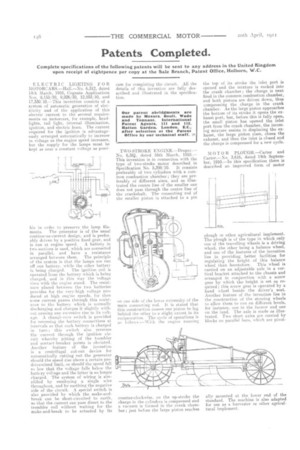Patents Completed.
Page 18

If you've noticed an error in this article please click here to report it so we can fix it.
Complete specifications of the following patents will be sent to any address in the United Kingdom upon receipt of eightpence per copy at the Sale Branch, Patent Office, Holborn, W.C.
ELECTRIC LIGHTING FOR MOTORCARS.—Hall.—No. 6,312, dated 14th March, 1910, Cognate Applications Nos. 8,155/10, 9,926/10, 12,893110, and 17,330:10.—This invention consists of a system of automatic generation of eketricity and of the application of this electric current to the several require. ments on motorcars, for example, headlights, tail light, internal illumination, ignition, and electric horn. The current required for the ignition is advantageously arranged automatically to increase in voltage as the engine speed increases, but the supply for the lamps must be kept as near a constant voltage as poser tole in order to preserve the lamp fila ments. The generator is of the usual continuous-current design, and is preferably driven by a positive fixed gear, and is run at engine speed. A battery in two sections is used, which are connected in parallel, and have a resistance arranged between them. The principle of the system is that the lamps are run off one battery, while the other battery
is being charged. The ignition coil is operated Trom the battery which is being charged, and in this way the voltage rises with the engine sneed. The resistance placed between the two batteries provides for the very-high voltage produced at high engine speeds. for then some current passes through this resistance to the battery which is normally discharging and charges it slightly without causing any excessive rise inn its voltage. A change-over switch is provided for reversing the battery connections at intervals so that each battery is charged in turn ; this switch also reverses the current through the ignition circuit whereby pitting of the trembler and contact-breaker points is obviated. Another feature of the invention is a centrifugal cut-out device for automatically cutting out the generator should the speed rise above a certain predetermined limit, or should the speed fall so low that the voltage falls below the batkry voltage and the latter is no longer ('barged. The system of wiring is simplified by employing a single wire throughout, and by earthing the negative side of the circuit. A special switch is also provided by which the make-andbreak can be short-circuited to earth. so that the current can pass direct. to the trembler coil without waiting for the make-and-break to be actuated by its
cam for completing the circuit. All the details of this invention are fully desscribed and illustrated inn the specification.
T WO-STROKE ENO INE.—Draper. — No. 6,58J, dated 16th March, 1910— This invention is in connmtion with the type of two-stroke motor described in Specification No. 5,398/10. It consists preferably of two cylinders with a common combustion chamber; they are preferably of different sizes, and as illustrated the centre line of the smaller one does not pass through the centre line of the crankshaft. The connecting rod of the smaller piston is attached to a pin on one side of the lower extremity of the main connecting rod. It is stated that this construction causes one piston to lag behind the other to a slight extent in its reciprocation. The cycle of operations is as follows :—With the engine running counter-clockwise, on the up-stroke the charge in the cylinders is compressed and a vacuum is formed in the crank chamber; just before the large piston reaches the top of its stroke the inlet port is opened and the mixture is sucked into the crank chamber ; the charge is next fired in the common combustion chamber, and both pistons are driven down, thus compressing the charge in the crank chamber. As the large piston approaches the bottom of its stroke it opens the exhaust port, but, before this is fully open, the small piston has opened the inlet port from the crank chamber, the incoming mixture assists in displacing the exhaust, the large piston rises, closes the exhaust, and then the inlet is closed and the charge is compressed for a new cycle.
M 0 T 0 R PLOUGH.—Carter and Carter.—No. 3,616, dated 14th September, 1910.—In this specification there is described an improved form of motor
plough or other agricultural implement. Tho plough is of the type in which only one uf the travelling wheels is a driving wheel, the other being a balance wheel, and one of the features of the invention lies in providing better facilities for regulating the height of this balance
wheel than heretofore. This wheel is carried on an adjustable axle in a vertical bracket attached to the chassis and arranged in conjunction with a screw gear by which the height is set as required; this screw gear is operated by a hand wheel beside the driver's seat. Another feature of the invention lies in the construction of the steering wheels to allow them to run on different levels, for instance, one in the furrow and one on the land. The axle is made as illustrated. Two short axles are carried by blocks on parallel bars, which are pivot ally mounted at the lower end of the standard. The machine is also adapted for use as a harvester or other agricultural implement..


















